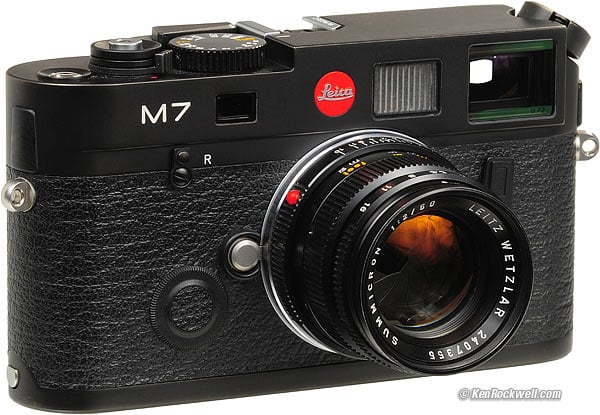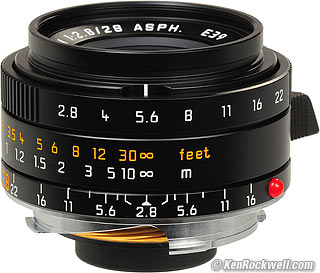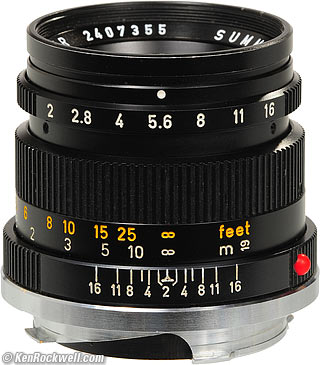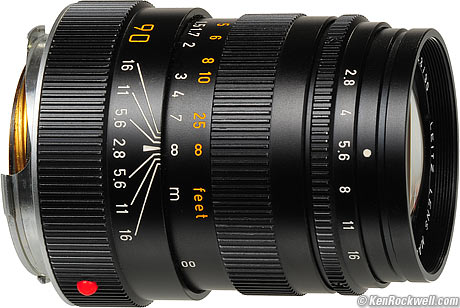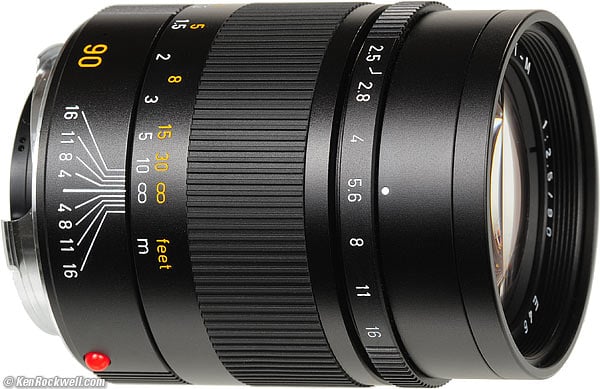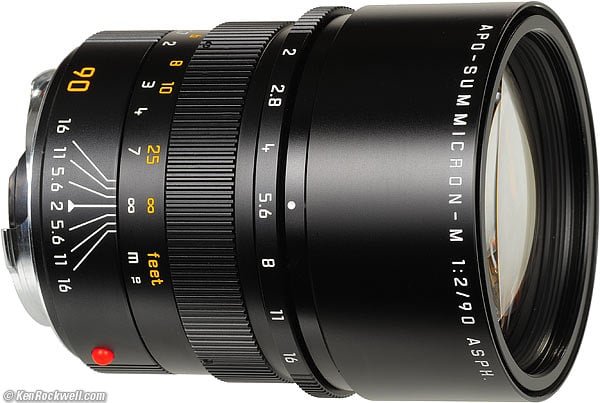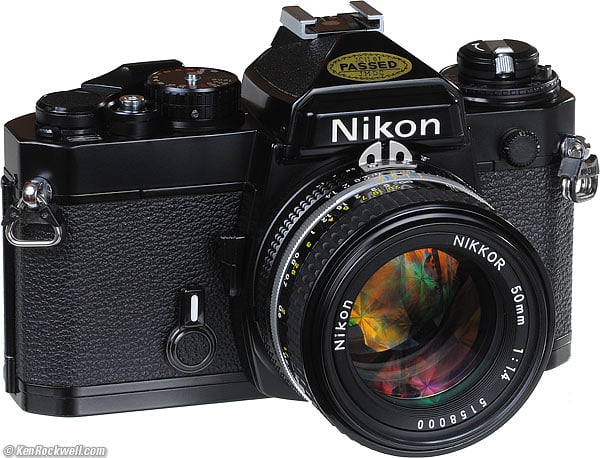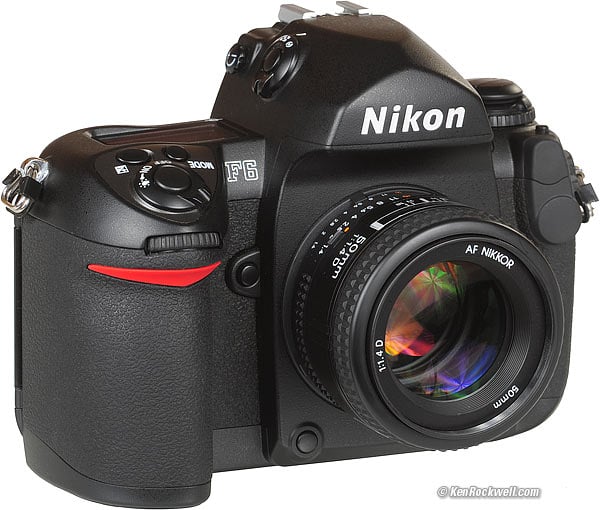Home Donate New Search Gallery How-To Books Links Workshops About Contact
A Complete Leica M System for Under $4,000
© 2009 KenRockwell.com. All rights reserved.
My Leica M7 and 50mm f/2 lens, which cost me just $2,100 still in its box. It helps me keep adding to this site when you use these links to get your goodies. Thanks! Ken.
February 2009 Leica Camera Reviews Leica Lens Reviews
|
I personally buy from Adorama, Amazon, Ritz, B&H, Calumet and J&R. I can't vouch for ads below.
|
Digital shooters tend to forget that classic camera gear is timeless.
This isn't just marketing poof; it means you can buy the exact same stuff used for a song instead of buying it new!
Especially with Leica, used equipment is often still in its original boxes with instructions and all accessories, just as it left the factory, at a fraction of the new price.
You have to be a careful shopper, and if you are, you can shoot the best for a fraction of new.
Compared to the Oriental makers, Leica rarely comes out with anything new. Leica makes it right to begin with so you don't have to replace it every 18 months. So long as you stay away from anything digital (Leica dumped the M8 for the M8.2 in about 24 months), most of the current new Leica catalog dates from the 1990s. This means it's easy to find and buy just about anything used.
Unlike Oriental brands, which deliberately obsolete features and lenses so you have to buy new stuff every 20 years or so, Leica doesn't do this. All their lenses from 1954 on work perfectly with today's cameras. All their bodies made since 1954 work perfectly with every lens made today.
The only gotcha is that the early 21mm Super-Angulons go too far into the body to meter well with the TTL cameras, but other than that, pick up a 1954 lens, and it works exactly as does a brand-new one. There are no features missing or only partly compatible. That's why old Leica stuff remains expensive: it's still good, and easy to get serviced. That's also why you can stock up on your gear at the used counter, cheap.
Since a reader asked, here's how I completed state-of-the-art ultralight Leica system for just under $4,000:
New |
Used |
Source |
|
| 28mm f/2.8 ASPH | $1,500 (rebated) |
n/a |
|
| 50mm f/2 (1970) | $399 |
||
| 90mm f/2.8 Tele (German, 1987) | $400 |
||
| Leica M7 | $1,699 |
||
| Subtotal | $9,800 |
||
| I Paid | $3,998** (41¢ on the dollar) |
* Current models. The current 90/2.8 is bigger and heavier than the Tele, and has very slightly better performance wide-open. I prefer the lighter Tele.
** I got the 28mm new with a rebate, and the rest used.
Not to spill any secrets, but I also bought a big, fat 90mm f/2 APO-SUMMICRON-M Aspherical for just $1,450, over eBay from Adorama's used store, still in the box with all the paperwork. It sells new for $3,500. If you want the current, larger $2,000 90mm f/2.8, it usually sells for about $700 used on eBay.
How do I find these deals? Easy: I keep my eyes peeled, and I know How to Win on eBay. For instance, the 90mm APO, which I got for under 42¢ on the dollar, I got because the eBay auction closed on New Years' eve when the rest of the world was out boozing it up. I bid at the last second with no competition. Adorama boxed themselves out of a good price by putting too high a starting bid, so no one bid, and I got it for the starting bid. I presume Adorama didn't realize when they listed it that it would close on New Year's Eve, hee hee. Others get better deals than I do; I'm more cheap than I am an expert at this.
Why Leica top
Why not? Recovering from digital, where we thought nothing of flushing a couple of grand down the toilet on disposable DSLRs every 18 months, this stuff is cheap, and will be worth at least what we paid for it when we tire of it, if we tire of it.
If money mattered, The Contax G System does exactly the same thing as Leica M, has the same superior optics, and handles a bit better for about $1,200 for this same complete system!
The Leica or Contax G systems are for people who need the smallest and lightest possible RealRawtm camera systems. SLR cameras do far more, but are much bigger. Smaller cameras go farther and get you into places others won't.
Why The M7 top
Any old Leica M, especially since the M4-P of 1980 which is the first Leica with a finder that covers 28-135mm, works great. You will of course need a manual meter, like the modern DigiSix and hot-shoe adapter, or any old clip-on LEICAMETER with any Leica earlier than the LEICA M6 (unless you're a master like Salgado, who has enough experience to guess his exposures off the top of his head).
I like the M7 because it doesn't cost much more used than any other Leica M, and I'm a huge fan of its superior time-exposure and low-light ability. The M7 makes auto exposures out to 38 seconds, and times my bulb exposures for me out to 16 minutes.
Why The M6 top
If you don't mind manual metering, the mechanical LEICA M6 costs even less, like $1,000 less, than the M7.
Why these lenses? top
Because they are optically great, they are tiny, and all take the same puny 39mm filters.
Leica is all about small and light. If you want to weigh yourself down with heavy lenses, you may as well shoot a better camera like an SLR like the Nikon F6 and AF lenses, which lets you shoot even faster and therefore more creatively.
Shooting big Leica lenses, like the 90mm f/2 APO instead of the tiny 90mm f/2.8 Tele that weighs over twice as much as any of my other Leica lenses, is untrue to the heritage and purpose of all that is Leica.
Why this System? top
Because these three lenses, film, batteries, body and etc. weigh just under three pounds (1,350g).
As a RealRawtm system, there's no need for any computers, cables, chargers, power sources, plugs, cards or anything: you can just shoot.
There are a lot of other lenses I might want, but when your whole setup is this light, it encourages you to go running out to places you otherwise might not.
28mm top
Leica 28mm f/2.8 ASPH (39mm filter, 6.107 oz./173.18g).
Leica's newest 28mm lens is also their best because its so tiny that it doesn't block the viewfinder, and it has no distortion. Of course it's sharp, even wide open. Compared to SLR lenses, it's superior.
Like all symmetrical, distortion-free wide lenses, the Leica 28mm f/2.8 ASPH has pleasant falloff at all apertures. This helps keep viewers' eyes inside the image without wandering off in the corners.
I had to get it new because there aren't enough of them out on the used market, since this lens was introduced in 2006. Not only that, but any older 28mm Leica lens sells for at least $1,000 used, even if it's 30 years old, so you may as well get the best new.
I passed on the 28mm f/2 as being disrespectful to Leica heritage and purpose because it's too big (46mm filters), and also blocks my viewfinder.
50mm top
Leica 50mm f/2 (1970, 39mm filter, 7.080 oz./200.7g). enlarge.
This old German 50mm lens is superb. Compared to SLR lenses, it's superior. I see no reason to buy the newest version of the 50mm f/2 if you're on a budget.
I especially don't want the bigger, fatter f/1.4 50mm. It's not as good optically, and for low light, digital is still the way to go, as in even a Nikon D40.
Forget the Noctilux; they have poorer performance than the f/2 50mm lenses at normal apertures.
90mm top
Leica 90mm f/2.8 Tele (1987, 39mm filter, 7.957 oz./225.6g). enlarge.
This is the most Leica of any Leica 90mm lens because of its small size and high performance. It is Leica incarnate.
"Tele" formally means a lens which sticks out less from the film plane than its rated focal length. Leica's other non-tele 90mm lenses, which are everything they make today, stick out more.
In spite of sales literature which tries to scare you away from this bargain used tele lens in favor of buying Leica's newest $2,000 non-tele 90mm f/2.8 or the porker (by athletic German Leica standard) 90mm f/2 APO ASPH below, I see little or no difference in optical performance, but vast differences in portability.
This 90mm Tele-Elmarit-M is super sharp, even wide-open. The only tiny performance difference is barely visible at f/2.8 and f/4, and I'd rather carry this tiny lens with its standard 39mm filter size instead of any of the bigger 90mm Leica lenses.
Most people shooting Nikon or Canon would be using a huge 80-200 or 70-200mm f/2.8 zoom to do the same thing as this tiny tele 90mm f/2.8 lens. Not only do those zooms weigh more than SIX times as much as this lens (or as much as this entire core Leica system), this 90mm lens is sharper and has less distortion and vignetting than those zooms, hee hee.
90mm f/2.5 Summarit-M top
Leica 90mm f/2.5. (46mm filter, 12.140oz./344.2g.) enlarge.
This is Leica's latest Series-E style (Summarit-M) lens.
I bought one new and returned it. Leica ignored the history of Nikon, who tried this same business plan and failed. Oops!
Leica's 90mm f/2.5 is optically superb and smaller and lighter than the latest $2,000 90mm f/2.8, but it feels slightly dinkier than other Leica lenses of any era, used or new.
Since I can buy the nicer $2,000 90mm f/2.8 used for less than half the after-rebate $1,300 of this 90mm f/2.5, I passed on this f/2.5.
If you only buy new, this f/2.5 is Leica's current smallest and lightest 90mm lens, and therefore the most in resonance with the Leica spirit.
90mm APO "Dickes Ding" top
Leica 90mm f/2 APO ASPH (55mm filter, 16.675 oz./472.77g). enlarge.
The Leica 90mm f/2 APO ASPH is for people who like to sit around and compliment themselves on their extraordinarily discriminating taste in selecting fine tools.
The 90mm APO is a lab queen.
Yes, in a lab shooting flat targets its MTF numbers amaze the innocent, but shooting real 3-D subjects these benefits go away as soon you deviate away from the theoretical perfection of perfect focus on a flat subject.
If you shoot landscapes which are entirely at infinity, this APO can be a tad sharper than the old 90mm Tele, but that's it.
If you don't mind carrying this, the APO is an absolutely magnificent lens, and it's extra poundage in the front might actually help stabilize the camera, but I do mind carrying an overweight lens. This APO weighs over double what the 90mm Tele does, and for that extra weight, a second lens would give me far more photo opportunities than one extra stop.
I prefer to leave the APO back in the safe deposit box and take the 90mm Tele out in the field instead.
Why not Cosina? top
My heritage is 100% German and European. If I can buy real Made-in-Germany quality products (not just a name), I do.
Cosina makes swell Japanese cameras, like the Voigtländer and most of the Zeiss brands, but when I last shopped for them, I realized that I could buy a used Nikon F6 for the same price, so I did.
When it comes to lenses, it's silly to pay top dollar for a Leica camera and cripple it with mushy-feeling foreign lenses, even just for the feel alone.
If I was going to struggle with an off-brand rangefinder camera, I'd choose the Zeiss Ikon over the Voigtländers because the Zeiss Ikons look much better. Do looks matter? Of course they do, that's what photography is all about. If you can't appreciate beauty, why do photography? You're not buying rangefinder cameras to be practical.
I would have a hard look at the tiny Cosina 21mm f/4, with its authentic 39mm filter thread, more true to the Leica brand and spirit than Leica's own overgrown 21mm f/2.8 and f/1.4. I'll let you know if I get to testing any of them. I'm unsure if the Cosina (Voigtländer) 21mm allows proper TTL metering on the Leica bodies.
If you want to save money, go for the mostly superior Contax G System instead. I don't get the point of buying into obsolete, clumsy rangefinder camera systems unless I at least get some German bloodline along with it. Rangefinder cameras are pretty silly, so I'd move straight to the head of the class, the Contax G, if I wanted anything other than real German quality.
Nikon FE.
Great question!
The 1978 Nikon FE outperforms the Leica M7, and you can get used FEs for under $99.
For lenses, I'd suggest the Nikkor 28mm f/2.8 AI or 28mm f/2.8 AI-s, any 50mm from the 50mm f/1.8 Series E to the 50mm f/1.4 AI-s, and the 85mm f/2 AI-s. If you don't mind breaking the bank, the 28mm f/2 AI-s is another favorite of mine, which still sells used for less than one Leica body overhaul.
The reason to prefer the Leica, presuming you're loaded with post-digital dollars, is that the Nikon is too big and that the Nikkor SLR lenses aren't quite up to the performance of the Contax or Leica lenses.
For just a few hundred dollars for the whole system, the improved SLR viewing and ease of exposure setting more than ought to make up for the optics.
Why Not the Nikon F6?
Nikon F6.
Why not? Today's Nikon F6 is the world's best 35mm camera. Owning an F6, it almost seems like a crime to waste loading 35mm film into anything else.
Simple: the F6 is too big, and the Nikon AF lenses aren't up to the Leica or Contax lenses if you're pushing 25 megapixels in RealRawtm.
If you don't mind the weight, the F6 easily outperforms anything from Leica because of its infallible metering and autofocus systems.
Why Not the Nikon SP?
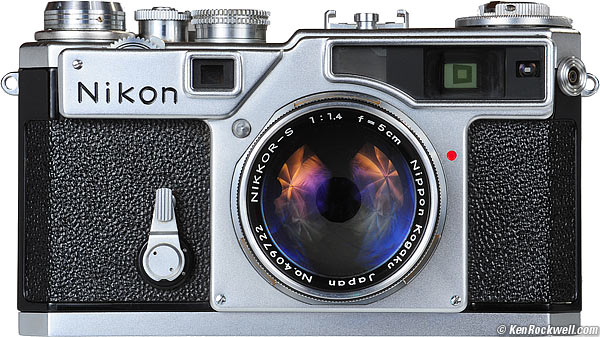
Nikon SP.
Nikon's SP rangefinder of the 1950s is nice, but nowhere near as well made as anything from Leica.
Old neglected Nikon SPs usually work better than neglected Leicas, but presuming they're working properly, nothing feels like a Leica. The old SPs feel like old Nikon Fs: nice, but still not Made in Germany.
Leica's lenses are better. I own a complete Nikon SP system. The SP's 3.5cm (35mm) f/2.5 and 8.5cm (85mm) f/2 lenses are excellent even today, but the 2.8cm (28mm) f/3.5 and 5cm (50mm) f/1.4 lenses are inferior.
Worse, the SP doesn't really work for serious photography on Velvia. My SP, which sat ignorred in a garage for a couple of decades before I adopted it, has shutter speeds still all within one-tenth of a stop, even at 1/1,000.
The problem with the SP system is that the diaphragms of the Nikkor rangefinder lenses are not well enough calibrated to allow consistent exposures, especially at smaller apertures. Not only do the Leica M7 and Contax G cameras meter through-the-lens to correct for this, the diaphragms of the Contax and Leica are much better calibrated if you are using external meters.
The Nikon rangefinder system was discontinued before Nikon brought TTL metering into production. You have to use an external meter with the SP.
I always measure and apply calibration corrections the the shutters of my large format lenses, but I give up when it comes to trying to compensate for fractional errors in numerous lens diaphragms.
PLUG
I support my growing family through this website.
If you find this as helpful as a book you might have had to buy or a workshop you may have had to take, feel free to help me continue helping everyone.
If you've gotten your gear through one of my links or helped otherwise, you're family. It's great people like you who allow me to keep adding to this site full-time. Thanks!
If you haven't helped yet, please do, and consider helping me with a gift of $5.00.
The biggest help is when you use any of these links when you get anything. It costs you nothing, and is this site's, and thus my family's, biggest source of support. These places always have the best prices and service, which is why I've used them since before this website existed. I recommend them all personally.
Thanks for reading!
Ken
Home Donate New Search Gallery How-To Books Links Workshops About Contact
